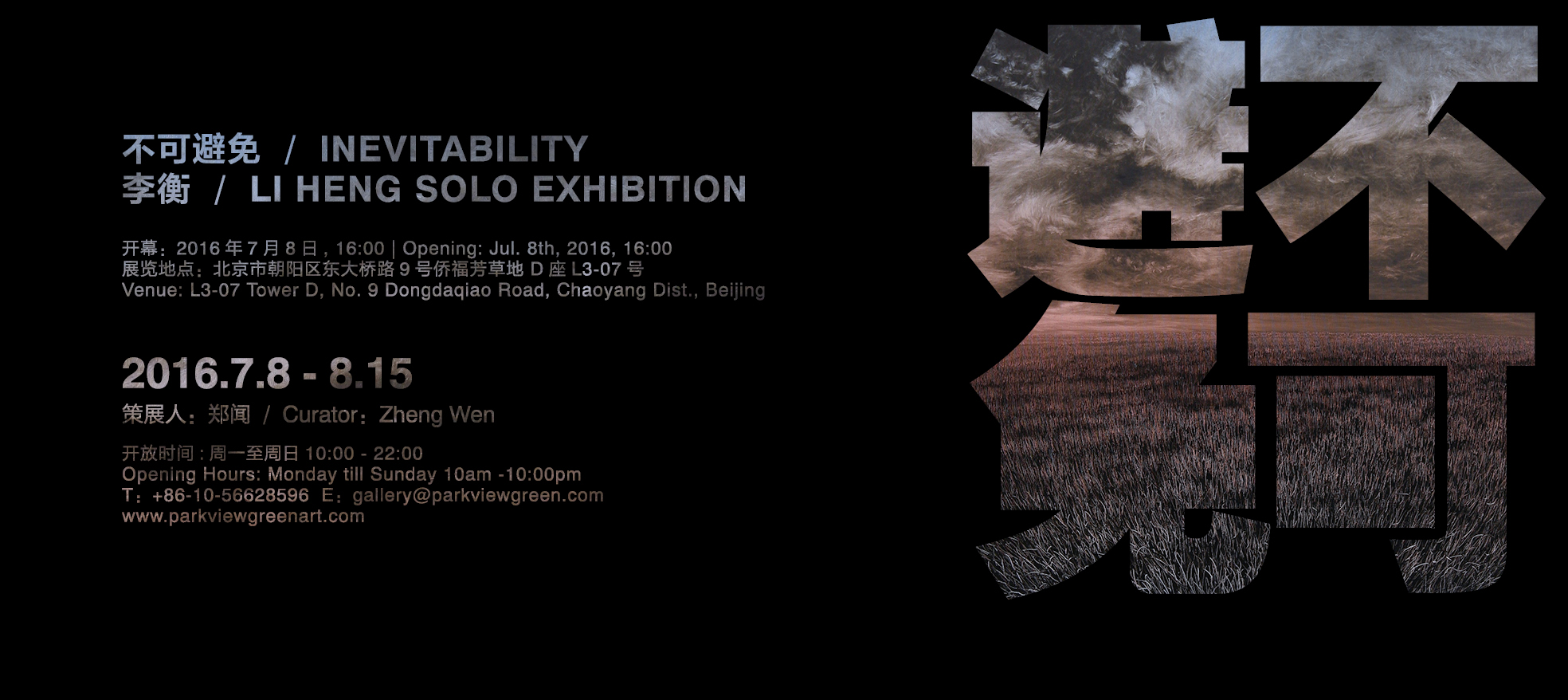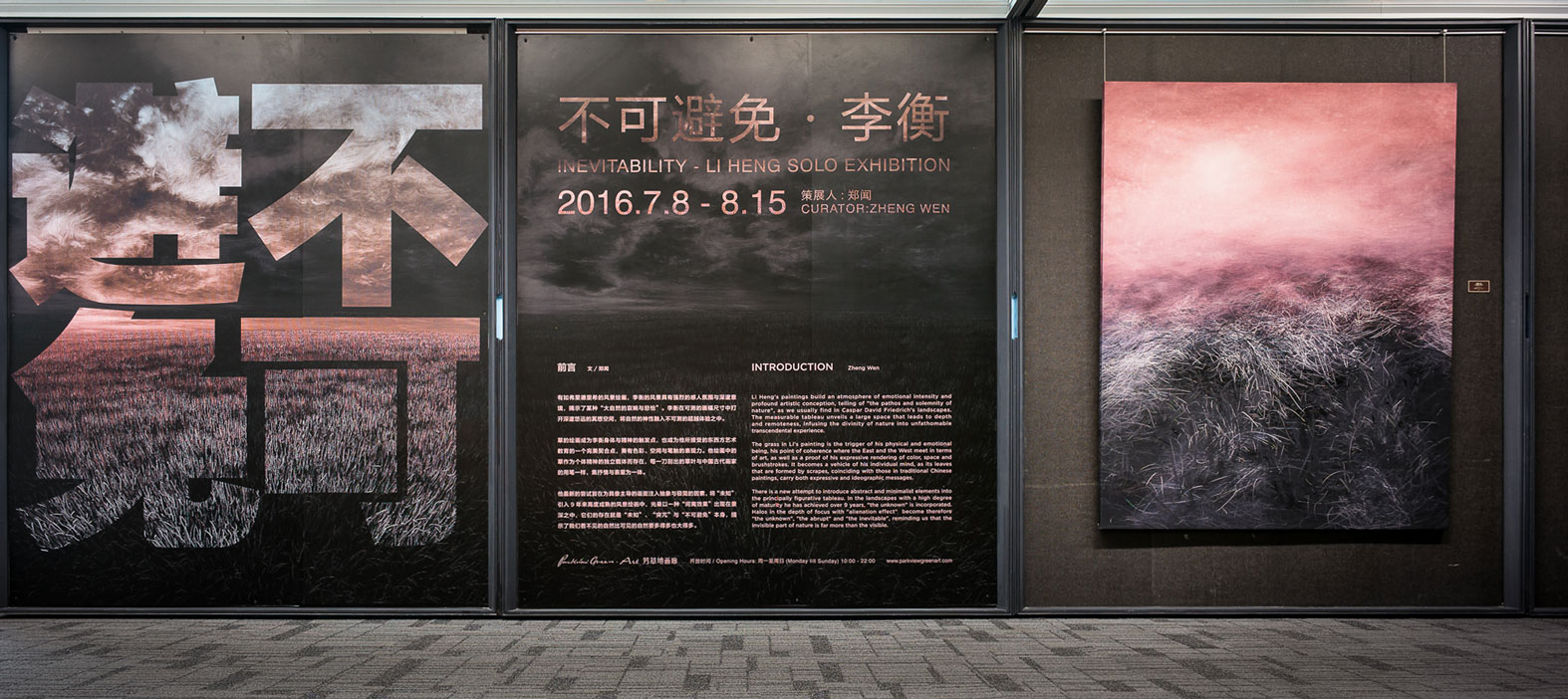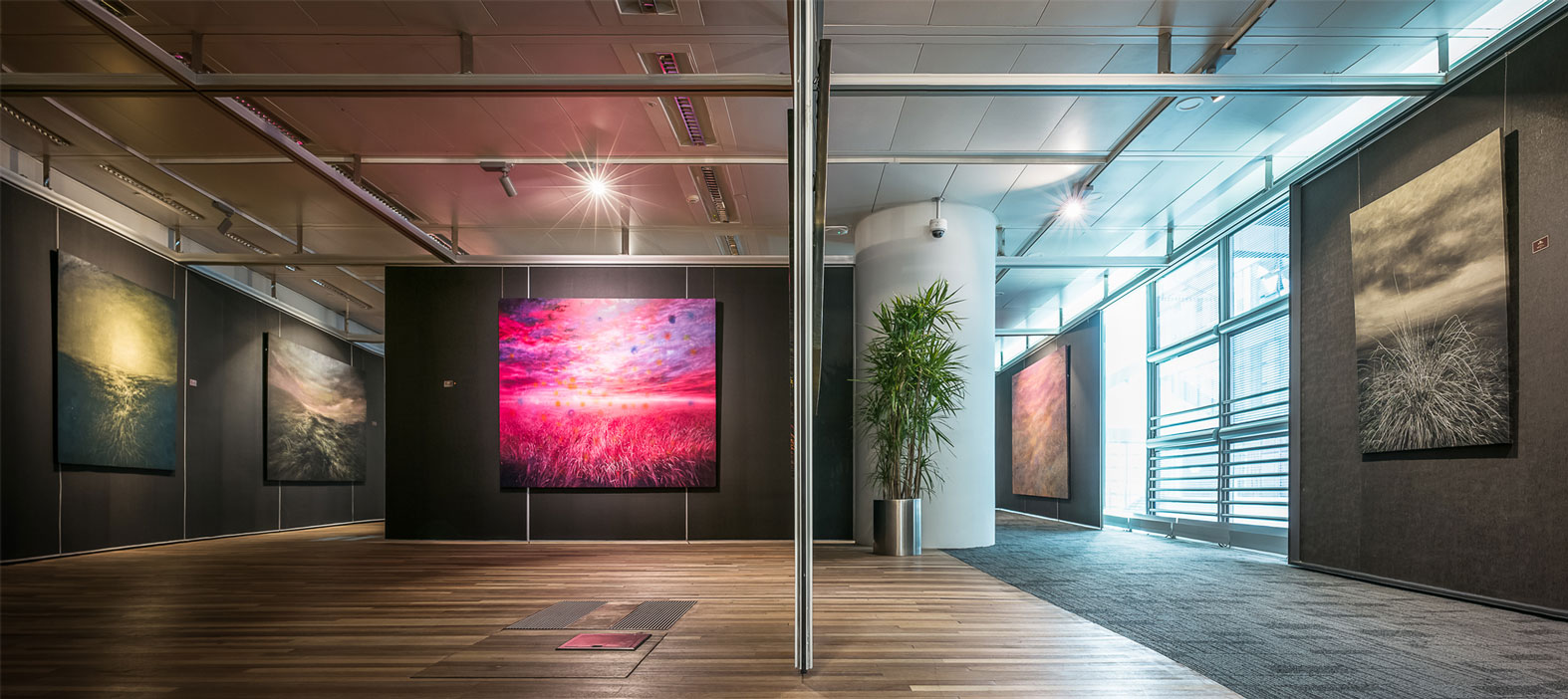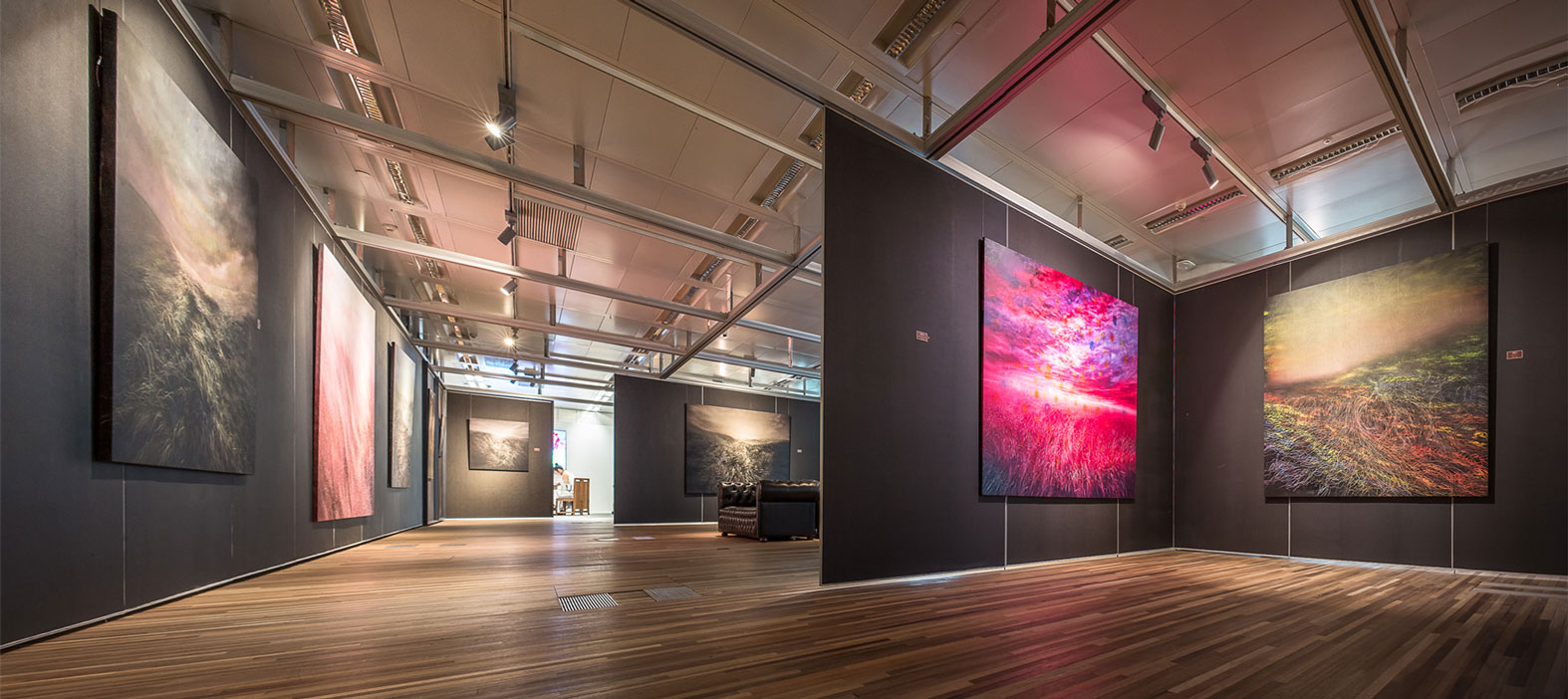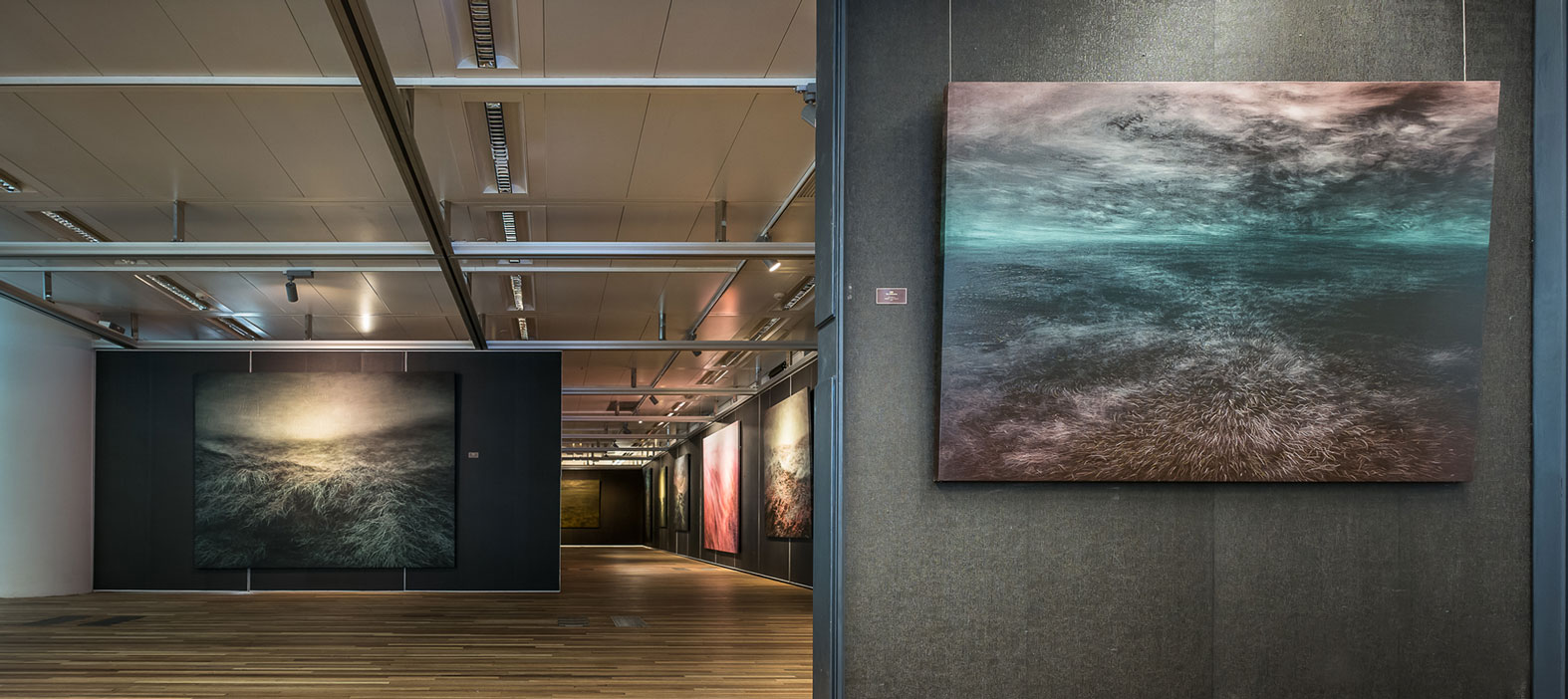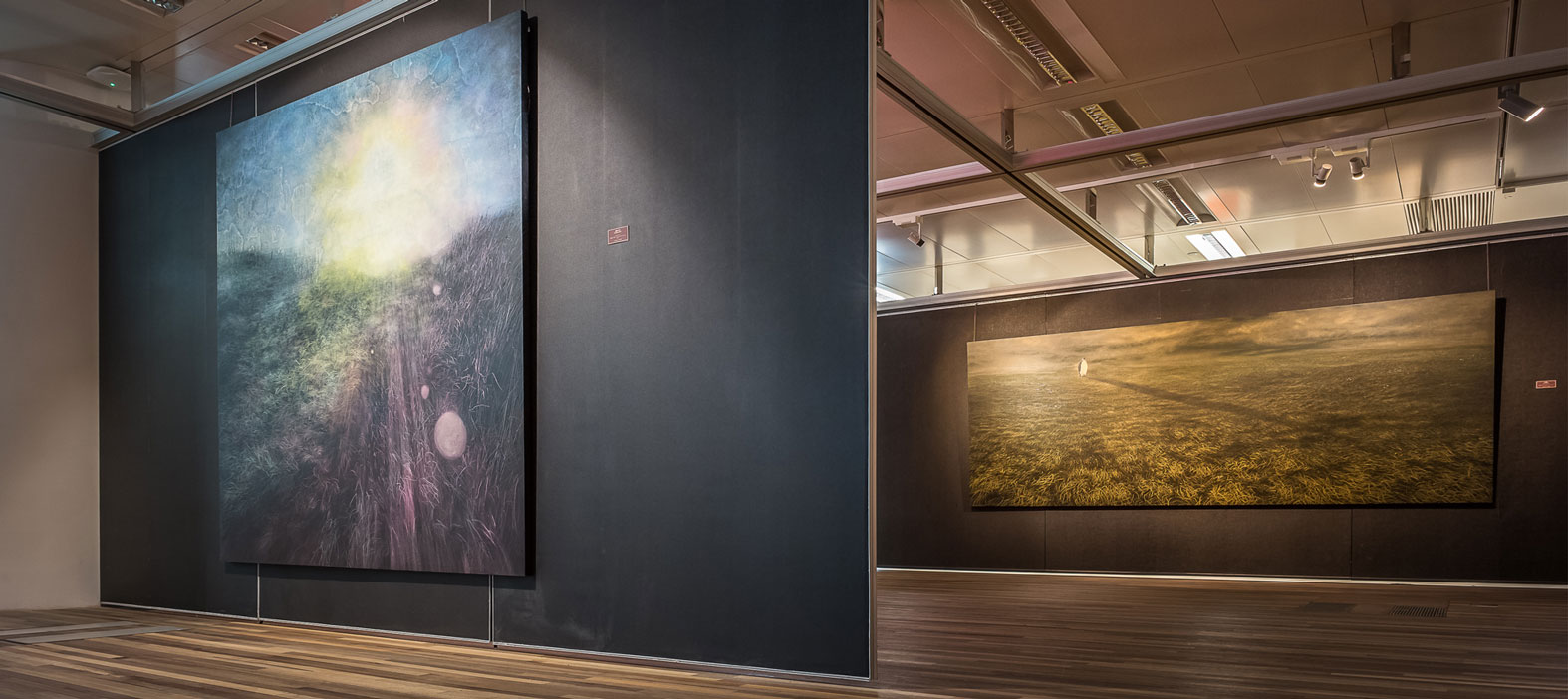Inevitability:Introduction to LiHeng’s Solo
Zheng Wen
Emile Verhaeren, aBelgian poet, once described the plains as something hanging around the city. Thebeggar-like soul begs every passersby, the infant-like city shakes the landignorantly with its soft hands, the buildings, growing like sharp teeth,devours the open sky that used to belong to the plain…The poet, born in themiddle of the 19th century, forecast the natural landscape in the 20th centurythat is encroached upon by the city and modern life, as well as the loss ofsoul and belief among modern people. The poem also dwells on the free will andlife will that surge in the artist’s inner world: “plains”, symbolic ofhumanity and life, speaks of the power and energy that is hidden in the rollinggrassland.
Vagabond Plains
Li Heng is aChinese-German artist, who went abroad to study before he got 20, and has studiedin Europe for about 16 years. He has studied in several important art schools,like Middle School Attached to CAFA (China), Repin Academy of Fine Arts in St. Petersburg (Russia), Akademie der BildendenKünste Nürnberg (Germany). He graduated with the title of “Masterclass” from Akademieder Bildenden Künste Nürnberg in 2010, and settled down in München, where hehas been based since then. For the past nine years, empty wilderness, wild butclouded sky, vast plains have been the keynote of his works. As the tenacity ofwild grass is to be tested by strong wind, the wind or some invisible force hasto be reflected by the instant movement of the grass wave. In Li’s paintings,the vast grass wave on the plain is always pushed by some great power. The upsand downs in the sea of grass are like paths trodden by a huge brutalsleepwalking monster, queer and bizarre.
To know somethingabout the composition of the landscape and the religious composition, we canrefer to Caspar David Friedrich’s “Monk by the Sea” (1809), a romantic paintingnow collected in Alte Nationalgalerie in Berlin. Li Heng and Friedrich have somethingin common in terms of composition: three-step composition. Friedrich removedfrom the painting everything that could possibly appear on the sea so as toreduce the landscape to three elements only: the land, the sea and the sky,whereas Li has the wilderness, the prairie and the sky as his three elements inthe landscape. Of course, Li sometimes includes in his paintings only the grassand the sky, or sometimes only the grass, but light is always there tohighlight the gradation. The alignment of the three elements, involving noplots, follows a highly abstract principle of composition and leads to a senseof infinite two-dimensional extension. As to the two-dimensional surface, thereis a typical religious dual structure formed on the basis of the sky and the mundaneworld in Western classic painting.
Like the landscapepaintings by Friedrich, Li’s works build an impressive atmosphere ofprofundity. A kind of light from somewhere dim frequently appears in thesepaintings, either bursting forth from a faraway horizon like explosion orrevealing, as Friedrich did, “the sorrow and pathos of natural landscape”. The horizon,moreover, is often under pressure. When put in the lower part of the painting,the horizon seems to be propping up the upper part of the painting,difficultly, but fairly staunchly. Sometimes the horizon is put in the middleor upper part of the painting, but it functions as the confrontation betweenthe sky and the mundane world or the border of their power exchange. The senseof melancholy and vastness these paintings give to the eye sometimes puts theviewers in subtle trance and uneasiness. Little by little, the light from afar,while illuminating the dark wilderness, becomes the hope of the human soul. Theartist therefore opens a wide and open space for contemplation in a measurablepainting, adding natural divinity to the immeasurable transcendental experience.
Soul of the Grass
Grass plays a key rolein Li’s art in the sense that it follows the destiny to enter his view, becominga trigger point of his physical energy and emotions, as well as a perfect pointthat connects his education in art, in the East and in the West, with hisstyle. Viewed as a whole, the grass shows on one hand the subtle and strictchanges in spatial gradation, perspective and shift in the tone, elementstypical in the Western figurative painting, and expressive capacity of colorand brushwork that are common in both Western modern art and Eastern freehandbrushwork. It reminds me of John Everett Millais’ masterpiece “Ophelia” (around1851). Seeing this painting at Tate in London last winter, I was impressed notonly by the artist’s masterful treatment of Ophelia, quite ignorant of what wasto happen, her face, expression, and gesture, but also by his inclusion of allthe natural elements, like the plants around her, particularly the flower inher hand that she picked. Every stroke and tone of color is impregnated withinfinite emotion, beauty, and pain.
Millais’ concentratedand elaborate treatment of plants is later called “pictorial eco-system”,emphasizing the role of plants as vehicle of emotion. Li adopted the sameapproach in rendering the plants, but his works differ from “Ophelia” and lotsof pre-Raphaelite paintings for the lack of figures. No man is seen in Li’spaintings. Among his early works about grass, there was one featuring a plasticchair with a long shadow. It is this scene that evoke something special hisinner world and since then the plain has been one of his subject matter, butlike all artists in the real sense of the word, Li soon turned to the aestheticlanguage about grass. Little by little the plastic chair, as well as thepenguin, disturbed and lonely, receded from his painting, leaving only thegrass, the wilderness, the horizon, and the sky.
To express theemotions, a real artist, rather than depending on sad or complacent facialexpressions, refers to what is mundane and everyday landscape, or even thebrushwork only. Take Chinese calligraphy for instance. As an ancient art, it isabstract painting’s closest cousin. Every change in the trend, the vigor, andthe tone is intended to breathe life into the rich and subtle emotions. Overthe years, Li has been exposed to both Chinese and Russian plastic art, as wellas modern schools in Western modern art, and he finally forms his own stylethat echoes his inner world. In the close-up of the grass, we find somethingsimilar to the blank in Chinese cursive scripts. The grass therefore is nolonger part of the composition or part of the painting but an independentvehicle for the spiritual world.
We might as wellcompare Li’s close-up of the grass blades with the orchids in Chinese freehandpainting. Literati painters kept imitating until they got skillful with everydetail so that the orchid became the direct expression or treatment of theirown mind. Orchid painting, to some degree, is the pithiest and most abstractsubject matter, for it relies on nothing but the brushwork and the artist’sspiritual discipline to highlight symbolically the gradation and spatialrelationship between blades with only several highly generalized strokes intwo-dimensional space. The grass blades were not painted but formed by theblanks or traces of the ground color left by the scraper when running on the wetground color. The form, the structure and the trace of the grass also give usan idea of the movement of the artist’s arm and wrist make while painting, aswell as each exertion and shift in force. The grass blades by means ofscraping, like the orchid done with only one brushstroke in ancient Chinesepaintings, illustrates the way of generalization in Eastern art thatincorporates implication with signification in a single brushstroke.
Inevitability
It took a long timefor art to bid farewell to the Baroque style that stressed the effect depth inpainting and to embrace the Mondrian’sabstractpainting that spared no effort to remove the effect of depth. Thethree-dimensional effect and the sense of space vary from artist to artist indifferent time periods, and the human perception of space develops withscience, particularly physics. With his new effort, Li aims to add somethingabstract and minimalist to the principally concrete figurative painting in thecurrent practice, and it is also a further discussion about depth in painting.In the ultimate sense he is determined to incorporate “the unknown” into thealready highly mature landscape painting. In several of his recent landscapepaintings to be shown at this exhibition we can find some unusual dots andhalos, some hidden quite naturally in the landscape, some standing aloof andabrupt, hard to mix with the landscape around. These light dots and halos indifferent colors precede the landscape, occupy the painting like the active dotarray in Jerry Zeniuk’s abstract painting, and mix repeatedly with therepresentational landscape. These dots and halos, of varied colors, change inthe tone, the texture, the shape and the lightness while covering and mixingbefore ending up as different, highly characteristic and contingent ones.
At the conclusion ofthe painting, these halos are no more decorative, and rather, they become part of the depth in an “anti-depth”way and with “distance effect” in figurative landscape. Some of them are likeblack holes that suddenly appear in the natural space or like time and spacethat suddenly disappear, or like some mysterious “wormholes”. In a moreprofound or franker way, they are no other than “the unknown”, “the abrupt”,and “the inevitable”, giving expression to how the artist is in awe of theworld. It reminds me of the photos I took when passing the cornfield in thesuburbs of London in a summer. Gettingbored on the train, I put my Polo sunglasses in front of the lens of my mobilephone. When the sun passed through the lens, something magic took place. Aspiral halo, like a miracle, appeared above the cornfield in the photo. If wetake a look at Li’s early works, we can find that he had a very strong interestin multi-layered covering and recycled material. In “Time and Light”,photograph-painting about European cities, for instance, Li damped the photoshe took of the cities, and then kept painting and scraping with various toolsuntil amazing gradation and remarkable visual effect were achieved that standsbetween contingence and plan.
Li’s keen instinct andcuriosity in modern art give him impetus to move ahead. His interest in GüntherFörg, Sean Scully, Mark Rothko and many other abstract painters comes from hisremarkable sensitivity to the laws in painting, space and color gamut inparticular, as well as from his obsession with painting. His treatment of grasshas something to do with graffiti-like works by Cy Towmbly and many artists ofthe same genre on the unconscious level. Moreover his recent emphasis on halohas something in common with certain characteristic of the surrealistpaintings. In nature what is hidden from the artist is far more and larger thanwhat he can see. Here these halos or marks make their appearance in nature in astrange and anti-natural way, like what we see in Rene Magritte’s works,highlighting the visional part of the visible nature and the painted nature.
Light
It is nine years sincegrass became a major subject matter in Li’s paintings. In Chinese culture,nine, as number, is regarded the most “yang” that stands for abundance. In thephrase “Nine and nine returning to the original”, “nine” symbolizes a completecircle. On a rainy afternoon in the south, not knowing for sure how Li would goon with this series, when was preparing for his solo in Beijing I talked withhim on the phone. “As a painter, do you think you are directed to art historyor are just loyal to yourself?” I asked. “I don’t care about art history. It isabout nothing but conventions. Our in-depth study into art history is aimed toliberate us from these conventions. I am a painter, also an artist, but aboveall, a human being. Art is nothing more than a human enterprise. ” His answerput me at ease. As a curator and art critic, I know a lot about the commonanxiety among artists over whether they can be part of art history, somethinglike a haunting nightmare. Bothartists and art critics have gone too far about the presumed concept about theso-called history to be aware of the connection between art and the universalhuman nature.
To the artist, theplain and the painting as a whole are equal to the “landscape of his mind” thatthe world projected onto his inner world, vast and inclusive. Between thecosmos the painting symbolizes and the individual existence a grass leafsymbolizes arise powerful emotion and strong tension. By means of painting, theartist gains knowledge about the vastness of the world and the humbleness of ahuman being. The gloomy and sad atmosphere of the landscape, according to Li,reflects his feeling and impression of the common sufferings and disasters inthe world. The grass, like the multitude mortal beings, rooted in the earth andgrowing in darkness, is in the abyss of misery, but when there is light there ishope. Involved in the landscape and experiencing the same feeling, the artistgives non-verbal expression to the realization. In essence the recentbreakthroughs and trials in his art have something to do with his world view.The sea of grass, the horizon and the sky are symbolic of all living creatures,besides the visible world and abstract gradation. Not only the remarkable halosbut also the repeated rubbing on the wall’s rich texture are gradational. Theintroduction of the contingent and the unknown into art leads him closer to hisself while reaching the depth of our mysterious world.
The inevitable fatechooses Li, a mortal being, to be a gifted painter, so he has the opportunityto overwhelm himself in classic paintings and modern art, to equip himself withglobal cultural vision, and to gain rich experience, and above all, to conveythe sympathy and benevolence of human nature by means of his hands andpainting. What is the luckiest for him is that the inevitable fate brings himthe wilderness along the border of the city, the rolling sea of grass and thescudding clouds, but most importantly, the light.
Inevitability:Introduction to LiHeng’s Solo
Zheng Wen
Emile Verhaeren, aBelgian poet, once described the plains as something hanging around the city. Thebeggar-like soul begs every passersby, the infant-like city shakes the landignorantly with its soft hands, the buildings, growing like sharp teeth,devours the open sky that used to belong to the plain…The poet, born in themiddle of the 19th century, forecast the natural landscape in the 20th centurythat is encroached upon by the city and modern life, as well as the loss ofsoul and belief among modern people. The poem also dwells on the free will andlife will that surge in the artist’s inner world: “plains”, symbolic ofhumanity and life, speaks of the power and energy that is hidden in the rollinggrassland.
Vagabond Plains
Li Heng is aChinese-German artist, who went abroad to study before he got 20, and has studiedin Europe for about 16 years. He has studied in several important art schools,like Middle School Attached to CAFA (China), Repin Academy of Fine Arts in St. Petersburg (Russia), Akademie der BildendenKünste Nürnberg (Germany). He graduated with the title of “Masterclass” from Akademieder Bildenden Künste Nürnberg in 2010, and settled down in München, where hehas been based since then. For the past nine years, empty wilderness, wild butclouded sky, vast plains have been the keynote of his works. As the tenacity ofwild grass is to be tested by strong wind, the wind or some invisible force hasto be reflected by the instant movement of the grass wave. In Li’s paintings,the vast grass wave on the plain is always pushed by some great power. The upsand downs in the sea of grass are like paths trodden by a huge brutalsleepwalking monster, queer and bizarre.
To know somethingabout the composition of the landscape and the religious composition, we canrefer to Caspar David Friedrich’s “Monk by the Sea” (1809), a romantic paintingnow collected in Alte Nationalgalerie in Berlin. Li Heng and Friedrich have somethingin common in terms of composition: three-step composition. Friedrich removedfrom the painting everything that could possibly appear on the sea so as toreduce the landscape to three elements only: the land, the sea and the sky,whereas Li has the wilderness, the prairie and the sky as his three elements inthe landscape. Of course, Li sometimes includes in his paintings only the grassand the sky, or sometimes only the grass, but light is always there tohighlight the gradation. The alignment of the three elements, involving noplots, follows a highly abstract principle of composition and leads to a senseof infinite two-dimensional extension. As to the two-dimensional surface, thereis a typical religious dual structure formed on the basis of the sky and the mundaneworld in Western classic painting.
Like the landscapepaintings by Friedrich, Li’s works build an impressive atmosphere ofprofundity. A kind of light from somewhere dim frequently appears in thesepaintings, either bursting forth from a faraway horizon like explosion orrevealing, as Friedrich did, “the sorrow and pathos of natural landscape”. The horizon,moreover, is often under pressure. When put in the lower part of the painting,the horizon seems to be propping up the upper part of the painting,difficultly, but fairly staunchly. Sometimes the horizon is put in the middleor upper part of the painting, but it functions as the confrontation betweenthe sky and the mundane world or the border of their power exchange. The senseof melancholy and vastness these paintings give to the eye sometimes puts theviewers in subtle trance and uneasiness. Little by little, the light from afar,while illuminating the dark wilderness, becomes the hope of the human soul. Theartist therefore opens a wide and open space for contemplation in a measurablepainting, adding natural divinity to the immeasurable transcendental experience.
Soul of the Grass
Grass plays a key rolein Li’s art in the sense that it follows the destiny to enter his view, becominga trigger point of his physical energy and emotions, as well as a perfect pointthat connects his education in art, in the East and in the West, with hisstyle. Viewed as a whole, the grass shows on one hand the subtle and strictchanges in spatial gradation, perspective and shift in the tone, elementstypical in the Western figurative painting, and expressive capacity of colorand brushwork that are common in both Western modern art and Eastern freehandbrushwork. It reminds me of John Everett Millais’ masterpiece “Ophelia” (around1851). Seeing this painting at Tate in London last winter, I was impressed notonly by the artist’s masterful treatment of Ophelia, quite ignorant of what wasto happen, her face, expression, and gesture, but also by his inclusion of allthe natural elements, like the plants around her, particularly the flower inher hand that she picked. Every stroke and tone of color is impregnated withinfinite emotion, beauty, and pain.
Millais’ concentratedand elaborate treatment of plants is later called “pictorial eco-system”,emphasizing the role of plants as vehicle of emotion. Li adopted the sameapproach in rendering the plants, but his works differ from “Ophelia” and lotsof pre-Raphaelite paintings for the lack of figures. No man is seen in Li’spaintings. Among his early works about grass, there was one featuring a plasticchair with a long shadow. It is this scene that evoke something special hisinner world and since then the plain has been one of his subject matter, butlike all artists in the real sense of the word, Li soon turned to the aestheticlanguage about grass. Little by little the plastic chair, as well as thepenguin, disturbed and lonely, receded from his painting, leaving only thegrass, the wilderness, the horizon, and the sky.
To express theemotions, a real artist, rather than depending on sad or complacent facialexpressions, refers to what is mundane and everyday landscape, or even thebrushwork only. Take Chinese calligraphy for instance. As an ancient art, it isabstract painting’s closest cousin. Every change in the trend, the vigor, andthe tone is intended to breathe life into the rich and subtle emotions. Overthe years, Li has been exposed to both Chinese and Russian plastic art, as wellas modern schools in Western modern art, and he finally forms his own stylethat echoes his inner world. In the close-up of the grass, we find somethingsimilar to the blank in Chinese cursive scripts. The grass therefore is nolonger part of the composition or part of the painting but an independentvehicle for the spiritual world.
We might as wellcompare Li’s close-up of the grass blades with the orchids in Chinese freehandpainting. Literati painters kept imitating until they got skillful with everydetail so that the orchid became the direct expression or treatment of theirown mind. Orchid painting, to some degree, is the pithiest and most abstractsubject matter, for it relies on nothing but the brushwork and the artist’sspiritual discipline to highlight symbolically the gradation and spatialrelationship between blades with only several highly generalized strokes intwo-dimensional space. The grass blades were not painted but formed by theblanks or traces of the ground color left by the scraper when running on the wetground color. The form, the structure and the trace of the grass also give usan idea of the movement of the artist’s arm and wrist make while painting, aswell as each exertion and shift in force. The grass blades by means ofscraping, like the orchid done with only one brushstroke in ancient Chinesepaintings, illustrates the way of generalization in Eastern art thatincorporates implication with signification in a single brushstroke.
Inevitability
It took a long timefor art to bid farewell to the Baroque style that stressed the effect depth inpainting and to embrace the Mondrian’sabstractpainting that spared no effort to remove the effect of depth. Thethree-dimensional effect and the sense of space vary from artist to artist indifferent time periods, and the human perception of space develops withscience, particularly physics. With his new effort, Li aims to add somethingabstract and minimalist to the principally concrete figurative painting in thecurrent practice, and it is also a further discussion about depth in painting.In the ultimate sense he is determined to incorporate “the unknown” into thealready highly mature landscape painting. In several of his recent landscapepaintings to be shown at this exhibition we can find some unusual dots andhalos, some hidden quite naturally in the landscape, some standing aloof andabrupt, hard to mix with the landscape around. These light dots and halos indifferent colors precede the landscape, occupy the painting like the active dotarray in Jerry Zeniuk’s abstract painting, and mix repeatedly with therepresentational landscape. These dots and halos, of varied colors, change inthe tone, the texture, the shape and the lightness while covering and mixingbefore ending up as different, highly characteristic and contingent ones.
At the conclusion ofthe painting, these halos are no more decorative, and rather, they become part of the depth in an “anti-depth”way and with “distance effect” in figurative landscape. Some of them are likeblack holes that suddenly appear in the natural space or like time and spacethat suddenly disappear, or like some mysterious “wormholes”. In a moreprofound or franker way, they are no other than “the unknown”, “the abrupt”,and “the inevitable”, giving expression to how the artist is in awe of theworld. It reminds me of the photos I took when passing the cornfield in thesuburbs of London in a summer. Gettingbored on the train, I put my Polo sunglasses in front of the lens of my mobilephone. When the sun passed through the lens, something magic took place. Aspiral halo, like a miracle, appeared above the cornfield in the photo. If wetake a look at Li’s early works, we can find that he had a very strong interestin multi-layered covering and recycled material. In “Time and Light”,photograph-painting about European cities, for instance, Li damped the photoshe took of the cities, and then kept painting and scraping with various toolsuntil amazing gradation and remarkable visual effect were achieved that standsbetween contingence and plan.
Li’s keen instinct andcuriosity in modern art give him impetus to move ahead. His interest in GüntherFörg, Sean Scully, Mark Rothko and many other abstract painters comes from hisremarkable sensitivity to the laws in painting, space and color gamut inparticular, as well as from his obsession with painting. His treatment of grasshas something to do with graffiti-like works by Cy Towmbly and many artists ofthe same genre on the unconscious level. Moreover his recent emphasis on halohas something in common with certain characteristic of the surrealistpaintings. In nature what is hidden from the artist is far more and larger thanwhat he can see. Here these halos or marks make their appearance in nature in astrange and anti-natural way, like what we see in Rene Magritte’s works,highlighting the visional part of the visible nature and the painted nature.
Light
It is nine years sincegrass became a major subject matter in Li’s paintings. In Chinese culture,nine, as number, is regarded the most “yang” that stands for abundance. In thephrase “Nine and nine returning to the original”, “nine” symbolizes a completecircle. On a rainy afternoon in the south, not knowing for sure how Li would goon with this series, when was preparing for his solo in Beijing I talked withhim on the phone. “As a painter, do you think you are directed to art historyor are just loyal to yourself?” I asked. “I don’t care about art history. It isabout nothing but conventions. Our in-depth study into art history is aimed toliberate us from these conventions. I am a painter, also an artist, but aboveall, a human being. Art is nothing more than a human enterprise. ” His answerput me at ease. As a curator and art critic, I know a lot about the commonanxiety among artists over whether they can be part of art history, somethinglike a haunting nightmare. Bothartists and art critics have gone too far about the presumed concept about theso-called history to be aware of the connection between art and the universalhuman nature.
To the artist, theplain and the painting as a whole are equal to the “landscape of his mind” thatthe world projected onto his inner world, vast and inclusive. Between thecosmos the painting symbolizes and the individual existence a grass leafsymbolizes arise powerful emotion and strong tension. By means of painting, theartist gains knowledge about the vastness of the world and the humbleness of ahuman being. The gloomy and sad atmosphere of the landscape, according to Li,reflects his feeling and impression of the common sufferings and disasters inthe world. The grass, like the multitude mortal beings, rooted in the earth andgrowing in darkness, is in the abyss of misery, but when there is light there ishope. Involved in the landscape and experiencing the same feeling, the artistgives non-verbal expression to the realization. In essence the recentbreakthroughs and trials in his art have something to do with his world view.The sea of grass, the horizon and the sky are symbolic of all living creatures,besides the visible world and abstract gradation. Not only the remarkable halosbut also the repeated rubbing on the wall’s rich texture are gradational. Theintroduction of the contingent and the unknown into art leads him closer to hisself while reaching the depth of our mysterious world.
The inevitable fatechooses Li, a mortal being, to be a gifted painter, so he has the opportunityto overwhelm himself in classic paintings and modern art, to equip himself withglobal cultural vision, and to gain rich experience, and above all, to conveythe sympathy and benevolence of human nature by means of his hands andpainting. What is the luckiest for him is that the inevitable fate brings himthe wilderness along the border of the city, the rolling sea of grass and thescudding clouds, but most importantly, the light.

